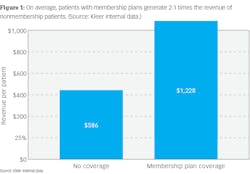Generate more revenue once the COVID-19 crisis passes without spending money on new-patient marketing
Every dental practice in the US has been impacted by the COVID-19 pandemic. But this crisis will pass, practices will reopen, and patients will return. A key to your success will be meeting the postcrisis needs of your existing patients.
How can you prepare for success and growth in a postcrisis environment?
A popular reaction to the crisis may be devoting a significant amount of time and budget to new-patient marketing. However, a fundamental truth of all businesses is that it’s cheaper and more profitable to market to existing customers than to find new ones. New-patient marketing is time-consuming, expensive, and provides minimal potential for creating long-term, profitable patients. According to a McKenzie Management survey, for every 10 patients who come into your practice, seven will never come back.1
There is a proven way to grow your practice without spending money on new-patient marketing. This article explores how dentists can grow their practices once the COVID-19 crisis lifts with a simple approach to generating revenue within their existing patient base.
Chart a new course: Focus on the revenue opportunity within your existing uninsured patient base
Most dentists have an undervalued asset that represents the most efficient, lowest cost opportunity to build their practices—their existing patients. These patients already know your staff and office. They trust the treatment you provide. You have already paid marketing dollars to acquire them and spent time building relationships. They do not require the costs associated with targeting and convincing new patients.
As existing patients return to your practice, it’s essential to take into account a new reality when you provide treatment. The COVID-19 crisis has created a backlog of treatment needs within your patient base. These patients have been unable to get the hygiene and nonemergency treatment they want. However, they will be more price-sensitive than ever due to a difficult economic environment, cuts in salaries, and losses of jobs and benefits.
Understanding your uninsured patients
Let’s explore one segment of your existing patient base that will require special care when the crisis lifts—your uninsured patients. Due to COVID-19 job losses, we estimate that as many as 50% of all patients will not have dental coverage. The good news is that uninsured patients value oral health—84% believe that their oral health is linked to their overall health, 75% believe that a healthy mouth leads to a better quality of life, and 60% believe that good oral health will help them live longer.2 However, only 17% of consumers without dental insurance visit a dentist each year.2 How can this be?
The two main reasons they do not visit are cost and coverage. Your uninsured patients feel exposed when it comes to getting dental treatment. They don’t know how much the dental care will cost, they don’t understand the pricing, and they feel uncomfortable negotiating fees.
This is where implementing a dental membership plan comes into the picture. A membership plan will provide your patients a budget-friendly way to access care and alleviate the worries that hold them back from visiting your practice and accepting treatment.
Unlocking opportunity
Dental membership plans unlock the opportunity within your existing uninsured patient base. Implementing a membership plan is an easy and virtual initiative your practice can do now to prepare for the future—and it requires no cost to your practice.
In addition to being cost-effective for your practice, a membership plan will provide your patients an affordable pathway to care and make it easy to do business with your practice. Practices and patients who have dealt with insurance plans know the frustrations that come with long agreements, annual maximums, waiting periods, claim delays and denials, etc. Membership plans do not include any of the red tape or hassles.
By making it easier for patients to get the care they need, a membership plan will create the “membership club effect” that will help your practice realize additional revenue. The return on investment is substantial and will help your practice bounce back from this crisis and thrive.
Kleer’s studies of practices offering membership plans to their patients show that membership plan patients complete two to three times more hygiene reappointments, accept two times more treatment, and generate twice the revenue of uncovered patients (figure 1).
The membership club effect
Two well-known books, The Membership Economy and The Automatic Customer, make the argument for membership plans.3,4 The basis of each is that membership creates a long-term, mutually beneficial relationship. Members gain access to products and services they want with simple and convenient terms, while companies offering memberships get loyal customers who purchase up to two times more than nonmembership customers. Essentially, the membership economy benefits any business that depends on repeat business from consumers who have other options.
The takeaway
In summary, implementing a membership plan is a simple way for your practice to prepare for life after the crisis. Your existing patients will be seeking budget-friendly access to care when you reopen. Not only will your patients benefit from affordable care, but your practice can thrive due to the proven strong return on investment of membership plans. Consider focusing your time on doubling the value of your existing uninsured patient base with this simple initiative.
References
- McKenzie S. Top reasons your practice keeps losing patients. McKenzie Management. July 29, 2016. http://www.mckenziemgmt.com/managementtips/print/sally/PrintSallyArticle751.html
- Finch Brands. Dental Market Insights Report. October 2018.
- Baxter RK. The Membership Economy. McGraw Hill Education; 2015.
- Warrillow J. The Automatic Customer. Portfolio/Penguin; 2015.
Dave Monahan is CEO of Kleer, a leading provider of subscription-based dental care. He can be reached at [email protected].
About the Author
Dave Monahan
Dave Monahan is CEO of Kleer, a leading provider of subscription-based dental care. He can be reached at [email protected].

